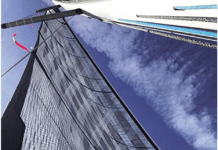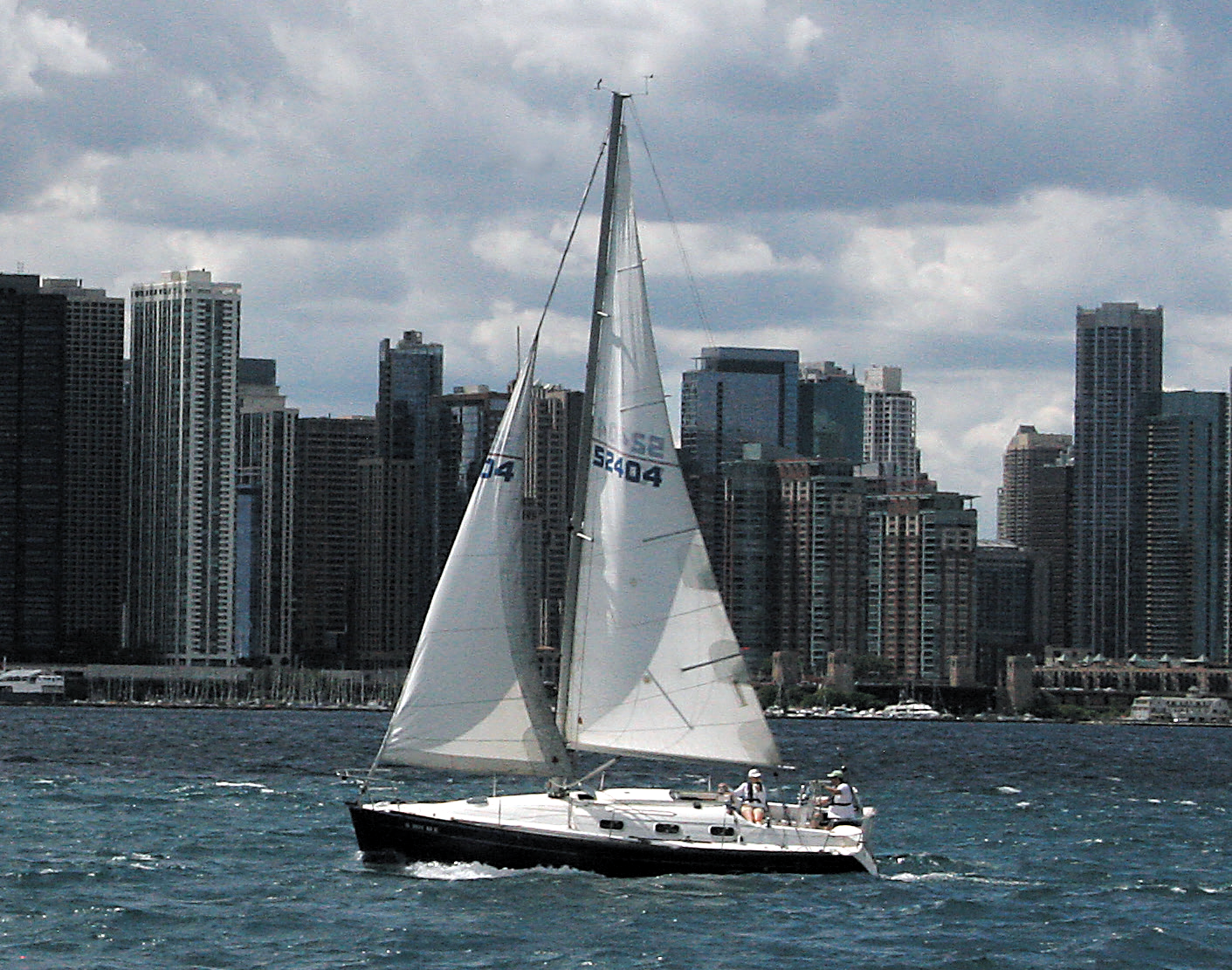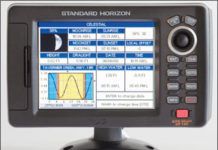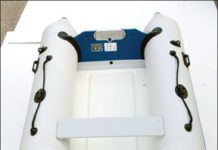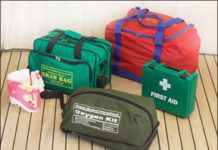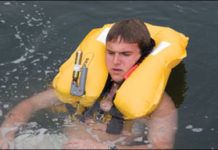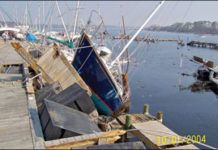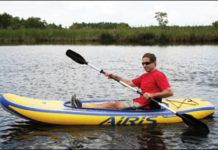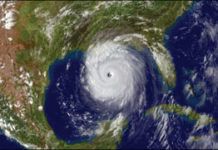Marine Electronics Test: A Look at Combination Fishfinders and Chartplotters
The test field includes devices with 5-inch display screens that provide chartplotting capabilities and information and show detailed bottom contours on a single display screen. These combination fishfinder-chartplotters are fitted with high-powered sounders. Practical Sailor tested units for day and night visibility. Each plotter was tested with live GPS fix information. Chartplotter user-interface was tested by examining actions such as creating waypoints, building routes, and changing map ranges. Units tested were the GarminGPSMAP 545s, which uses Garmin’s Bluechart g2; the Lowrance LMS-525C DF (a Navico brand), which has an NMEA 2000 GPS sensor, uses Navionics cartography, and is capable of interfacing with a Lowrance radar; the Raymarine A60/DSM25 combo; the SI-TEX Colormax SE; and the Standard Horizon CP180.
Rigid Inflatable Dinghies with Folding Transoms
In a follow-up to last months review of fixed-transom rigid inflatable boats, Practical Sailor looked at three 10-foot, folding-transom dinghies: the Walker Bay Genesis 310 FTD, Avon Rover 310 Lite, and the Zodiac Zoom 310SR. These three have the advantage of being easily stowed on deck, without taking up as much space as their fixed-transom counterparts. We tested each RIB dinghy for top speed, planing speed, overall performance at high and low speeds, spray deflection, and rowing. We looked at design, quality of construction, details, extras, price, and warranty-with an emphasis on price and warranty versus construction materials. PVC inflatable dinghies are not as durable as those made of Hypalon and generally carry a shorter warranty, but they are less expensive and can meet the needs of those in more temperate climates.
Mailport: 10/08
Your recent assessment of the locator service SPOT (Practical Sailor September 2008) was spot on. We recently took it along on a Pacific Coast, offshore delivery of a 50-foot sailboat. We hit bad weather and had several mechanical failures. Our families ashore were able to follow our progress on the SPOT website throughout our trip. The problem came when a panicked crew, unknown to me, hit the "911" button. I was able to cancel the 911 call a few hours later. Our families were simply alerted that we had a serious problem but did not know anything more for a couple days. The SPOT command central repeatedly called my cell phone, which was with me, 250 miles offshore and obviously out of range. They claimed they could not determine our position despite several days of track records.
Farewell to Skip Allan’s S/V Wildflower
Anyone who has ever run before a gale knows how exhilarating it can be. On the right boat, in the right conditions, the adrenaline rush is as intense as any we’ll feel in this world. Bull riders, surfers, and skydivers get a few seconds of excitement. An ocean gale can last for days ... and that’s where the problem lies. With your senses completely in tune with the boat, wind, and sea, the experience of hurtling down an ocean wave stirs the soul. But as the hours pass and day turns to night, the thrill gives way to exhaustion. Mostly, you’re too busy to be afraid, but each mountain of green water that fills the cockpit brings doubt. How high will these waves get? How long can I last? Even with a drogue streaming off the stern to slow down the boat, running before storm-driven waves entails a great deal of risk. There’s danger enough aboard a fully crewed boat, as the rig, sails, and steering gear get pushed to the brink.
Farewell to Skip Allans S/V Wildflower
Anyone who has ever run before a gale knows how exhilarating it can be. On the right boat, in the right conditions, the adrenaline rush is as intense as any we’ll feel in this world. Bull riders, surfers, and skydivers get a few seconds of excitement. An ocean gale can last for days ... and that’s where the problem lies. With your senses completely in tune with the boat, wind, and sea, the experience of hurtling down an ocean wave stirs the soul. But as the hours pass and day turns to night, the thrill gives way to exhaustion. Mostly, you’re too busy to be afraid, but each mountain of green water that fills the cockpit brings doubt. How high will these waves get? How long can I last? Even with a drogue streaming off the stern to slow down the boat, running before storm-driven waves entails a great deal of risk. There’s danger enough aboard a fully crewed boat, as the rig, sails, and steering gear get pushed to the brink.
Medical Kits for Offshore Cruising
Practical Sailor’s ongoing evaluation of medical kits continues with a review of pre-packaged first-aid kits designed for offshore cruising. These kits address a full-range of medical needs, from minor cuts, lacerations, abrasions, bruises and sprains to sunburn, seasickness, head trauma, fractures, hypothermia, and burns. Offshore first-aid kits are designed for sailors who might not have access to medical personal for more than 24 hours and contain equipment and medicines capable of sustaining badly injured crew. They also enable a trained caregiver on board to monitor an injured crew member while seeking advice of professionals via electronic communication. The three pre-packaged medical kits reviewed were the Adventure Medical Marine 2000, Fieldtex Coastal Cruising Pak, and OMI Class B Daytripper by Ocean Medical International.
Inflatable Life Jacket-Safety Harnesses Performance Test
Two years after last testing inflatable life jackets with integral safety harnesses (December 2006), Practical Sailor takes a look at those products that have since hit store shelves. This go-around, testers evaluated eight personal floatation devices (PFDs) to find the best inflatable life jacket-harness of the bunch and compare it to the 2006 top performer, the Mustang 3184 hydrostatic inflatable life vest and harness. Each life vest was tested for design and function, construction and materials, fit, comfort, and adjustability. Practical Sailor tested three PFD-harness combos from Bluestorm: the Pro Sail 33, X-treme Sail 33, and Sport Sail 33; two Revere ComfortMax series PFDs, one manual and one automatic/manual; the Helly Hansen HI250; and Protexion's Nautilus Deluxe. Testers favored the two vests from Revere Survival--both have a good fit on land and in the water, are readily available, and have moderate pricing and decent warranties. But neither topped the reigning Practical Sailor Best Choice: the Mustang automatic/manual inflatable PFD, which remains the favorite.
Gear for Battening Down Ahead of Storms
Practical Sailor offers an overview of products designed to help secure a boat for a major storm or hurricane. Well ahead of storm season, each boat owner should devise a hurricane preparation plan and should inspect the marina, dock, mooring, or hurricane hole where he intends to ride out the storm. One of the most important aspects of storm readiness is being sure you have the right gear and ground tackle to handle the loads of high winds and rising seas. In this overview, Practical Sailor takes a look at line choice and chafe gear for storm mooring. More line is obviously better, but more of what type and size? Editors discuss Fiorentinos RodeRap and LineRap, Davis Secure Chafe Guard, and the Chafe Guard from Taylor Made. We also consider docking aids including snubbers such as Shockles, Bungy Shock, and Synergy Marines braided poly dock lines; shock absorbers; and tidal-surge protectors including Tideminders, TideSlide, and the Slide-Moor.
Airis Inflatable Kayak a Start
Sailors tend to be independent souls, and more than a few cruising couples have found that having two ways to get ashore while on the hook can go a long way to maintaining marital bliss. Problem is, where to stow two dinghies on a boat that probably was designed without any thought about stowing even one? With that in mind, Practical Sailor began scouring the planet for high-quality inflatable kayaks. Recently improved by new technology, these boats look like a possible marriage saver that wont take up the whole quarter berth, or cost a fortune. Readers suggestions are welcome.
Trying to Reason With . . .
The article on hurricane gear starting on page 26 brought back memories of one of my most terrifying cruising experiences. In 1997, Super Typhoon Paka tore through the island of Guam while my wife and I were huddled on the cabin sole of our 32-foot ketch Tosca with our dog, Coco. Peak sustained speeds were later estimated at 100 miles per hour. Our boat was spider-webbed to trees, poles, and buried anchors along a shallow canal in Piti, a former Navy service area on the islands east side. In a basin nearby, a couple dozen sailboats were closely arrayed on four-point hurricane moorings. About five of those boats also had crew on board. Winds hit 50 miles per hour in the early evening, and didnt drop below that again until the next morning. Hurricane-force winds lasted for more than six hours. At the peak of the storm, the air was dense with debris, a scouring mix of sand, gravel, and leaves. Corrugated tin roofs, lumber scraps, and coconuts added to the potentially lethal rain. Several times, the empty CT 40 ketch to port would slam to starboard, and its rigging would scrape ours with a groan. At some point, hot wax from our hurricane candle dripped on Cocos nose. His howls added to the bedlam













